As a rider for over 50 years and writer for motorcycle magazines for more than 25 years, I’ve heard motorcyclists spout some bizarre beliefs. Here are some of the most enduring motorcycle myths. Each is bogus.
1. Loud pipes save lives. Loud pipes mean more power.
The first of my motorcycle myths is a twofer. First off, loud pipes don’t save lives, but becoming a better rider can. Some people also assume a louder exhaust (one with little or no baffling) makes more power. While a less restrictive exhaust may add a bit more horsepower at the top of the rev range, they often perform poorly unless corresponding changes are made to the intake side. OEM exhausts are designed to provide horsepower and torque where it matters – in the midrange where you spend most of your time riding.
2. Open-face helmets are just as good as full-face helmets.
Full-face motorcycle helmets provide better protection than open-face helmets because they cover the entire head, including the chin and face. Seeing photos of riders with the bottom half of their face torn off convinced me.
A meta-analysis in Preventive Medicine Reports found that full-face helmets reduce the risk of head injuries by 64% and neck injuries by 36% compared to open-face helmets. A full-face helmet’s faceshield protects the face and provides a clear view, and the fully enclosed design reduces noise by up to 30 decibels. Overall, full-face helmets provide better protection, more comfort, and increased safety.
See all of Rider‘s Helmet reviews here.
3. Using car tires on motorcycles is fine.
Does anyone still buy this myth? Using car tires on motorcycles can be dangerous. The Motorcycle Industry Council warns: “Never mount a passenger car tire on a motorcycle rim; the flat profile of a car tire is incompatible with the dynamics of a vehicle that leans as it corners, and the section of the tire in contact with the rim (the ‘bead’) is incompatible with motorcycle rims.”
Tales from the Dark Side, Eric Trow’s feature in Rider on this topic, includes a quote from motorcycle safety expert and AMA hall-of-famer David Hough: “Motorcycle engineers get up awfully early in the morning to calculate what works best for bikes. An owner who disregards the engineers’ advice should think carefully about his or her talents in being more clever than the engineers. The owner who installs tires not designed for the task must take full responsibility for the results.”
Related: Tales From the Dark Side: Putting Car Tires on Motorcycles
4. The rear brake stops a bike better than the front brake.
Using the front brake to stop a motorcycle is more effective and safer than relying on the rear brake. No exercise was practiced more and drilled into us harder during police motor officer training than proper braking. According to the Motorcycle Safety Foundation, the front brake provides over 70% of a motorcycle’s stopping power. It is more effective because as you brake, a motorcycle’s weight shifts forward, giving the front tire more grip. The front brake also provides better control and stability, especially in emergency situations, whereas the rear tire can lock up and skid, leading to loss of control. Using both brakes together provides the shortest stopping distance.
5. “I had to lay it down.”
This refers to intentionally laying a motorcycle on its side to avoid an impending crash. In other words, crashing to avoid a crash. This is not only pointless, it’s dangerous. Every millisecond of braking before impact reduces speed and the severity of damage. Experienced riders and safety organizations such as the MSF emphasize that riders should maintain control of the motorcycle and try to avoid an accident altogether through proper use of the brakes. Laying the bike down is a sign of panic and lack of proper training and experience. It can result in road rash, broken bones, and even death.
6. Lane splitting is dangerous.
Research has shown lane splitting reduces traffic congestion and improves traffic flow. A study by the University of California Berkeley found that lane splitting reduces traffic delays by up to 40%. Lane splitting can be safer for motorcyclists because it reduces the likelihood of being hit from behind by distracted or inattentive drivers. The study also found no increased risk of crashes for motorcyclists who practice it safely and responsibly. Once only allowed in California, it is now legal in various forms in four states. For more on this topic, check out Eric Trow’s feature, Split Decision: Are Lane Splitting and Lane Filtering Safe?.
7. BMWs are more reliable than other motorcycles.
I own a BMW motorcycle, and I’ve owned, ridden, tested, or rented bikes from nearly every major manufacturer. As you can expect, I have opinions about brand reliability, but don’t take my word for it. A 2015 Consumer Reports survey of 11,000 motorcycle owners provided the following ranking of brands in terms of reliability: 1. Yamaha, 2. Honda, 3. Suzuki, 4. Kawasaki, 5. Harley-Davidson, 6. Triumph, 7. Ducati, and 8. BMW.
See all of Rider‘s BMW coverage here.
8. Leather motorcycle apparel offers the best protection.
In truth, the best protective gear is the gear you use and wear all the time. In some instances, Kevlar (a synthetic material five times stronger than steel and with excellent abrasion resistance) and Cordura (a durable nylon that’s also resistant to abrasion) are considered superior to leather. They also weigh less than leather and can keep you cooler, a significant benefit in hot weather.
See all of Rider‘s Apparel reviews here.
9. Being a passenger on a motorcycle is just like being a rider.
Early in my riding days, I gave little thought to what my passenger was experiencing. Eventually, I wised up, and an article I wrote about riding with passengers became one of my most requested reprints. A passenger’s perspective on a motorcycle is very different from the rider’s. If you have any doubts, hop on the passenger seat and ride for 50 miles with someone else at the controls. Passengers can impact the bike’s handling. Riding with a good passenger is wonderful; riding with those who are scared or unfamiliar with how a motorcycle handles can be a total disaster.
10. Real riders never wash their bikes.
A good friend and fellow motorcycle journalist never washed his bike. He bragged that every bug he ever hit was still there. It was a case of pride over performance. My post-trip habit is to thoroughly wash and detail my motorcycle. In the process, I examine every cable and fastener to ensure it is snug and in its proper place. Going over the bike inch by inch, I often find little things wrong that, if unaddressed, could have caused big problems later. Riders should take the time to clean their own bike and know what to look for. This is the motorcyclist’s equivalent of a pilot flight pre-check. It can save your life.
11. Aftermarket performance accessories improve performance.
My friend Kevin Brown says one of the first things he learned at the Motorcycle Mechanics Institute was to ask the following questions of a rider who complained his bike was not running right: “What did you do to it? Did you add any accessories or make any performance enhancements?” Turns out a high percentage of bikes could be fixed by simply removing the addition. The chances you’ll improve the performance of your bike by adding something is highly unlikely. Usually it runs worse.
See all of Rider‘s Parts & Accessories reviews here.
12. Turn your handlebar in the direction you want to go.
Motorcyclists control the direction of travel by using “countersteering.” This means the rider turns or pushes the handlebar in the opposite direction of the turn. In other words, steer left to turn right, and vice versa. This works because as you turn in the opposite direction, the bike and rider will lean in the direction you wish to go. Many riders are unaware of this but make the correct movement unconsciously.
Related: Stayin’ Safe: Countersteering
13. Car drivers see motorcycles and will stop for you.
Automobile drivers don’t look for motorcycles the way they watch for other cars. They often will look directly at you yet fail to register the presence of a motorcycle. I credit a good part of my surviving so many motorcycle miles without incident to pretending my bike and I are wrapped in an invisibility cloak and no one can see me. Because of this mindset, I expect cars to pull out in front of me and am always prepared with a “Plan B.”
14. Only wusses wear protective gear.
Those who have had accidents often credit their protective gear with saving their lives. My riding friends operate with the motto ATGATT, meaning “All The Gear, All The Time.” Full protective gear includes a good helmet and armored jacket, gloves, pants, and boots. Some riders now use airbag vests or suits. Many seriously injured bikers lament from a hospital bed: “But I was only going three blocks to the store. I didn’t want to get all suited up just for that.”
15. Raingear keeps you dry in the rain.
I’m told some raingear works well. My experience, however, is that rain almost always seeps into small cracks or seams, and before I know it, I’m soaked. I’ve owned at least five pairs of “waterproof” gloves and only one pair worked. Same for boots. If you are riding in the rain, prepare to get wet.
16. Interstate highways are dangerous.
Interstate highways, while certainly not the most fun, are generally considered the safest place to ride a motorcycle due to their consistent speeds and limited access, which minimizes cross traffic. According to the NHTSA, interstates have the lowest fatality rates per mile traveled compared to other road types. Two-lane roads pose a higher risk due to their narrow lanes and lack of barriers between opposing lanes of traffic. City streets and parking lots pose the highest risk of accidents for motorcyclists due to higher levels of congestion, frequent intersections, and obstacles.
17. Riding side by side within a lane like Ponch and Jon on CHiPs is the best way to ride.
Motorcyclists are safest when riding in a staggered formation. It provides greater visibility and more space for emergency maneuvers and stopping. It also makes it easier to signal your fellow riders should the need arise.
Related: Stayin’ Safe: Group Riding Tips
18. Faced with a potential accident, you can avoid injury by jumping off your motorcycle.
Like “laying it down,” this may be tempting if it appears you are about to crash, but it’s a bad idea and will likely result in serious injury or death. Sticking with the motorcycle, attempting to control it, and having faith in its ability to stop, rapidly change direction, and get you out of a tight situation is nearly always the better choice. Motorcycles are far more capable than we give them credit for.
19. Once you set the correct tire pressure on your bike, you can forget it.
Tire pressure has a significant influence on the performance and safety of a motorcycle. Keeping both tires at the correct pressure provides the best ride quality, traction, stability, and control. Incorrect tire pressure negatively impacts wear on the tires and hurts your mileage. All motorcycle tires lose air to some extent, so it is imperative to always check for correct pressure before every ride.
In his book The Power of Myth, Joseph Cambell wrote that mythologies have value because they “support our quest for wisdom and happiness.” Loud pipes may make you feel cool, and backroads may be the most fun, but don’t believe loud pipes will save your life or that backroads are safer. Motorcycle myths are still myths – widely held but false beliefs.
See all of Rider‘s Tips & Tricks articles here.

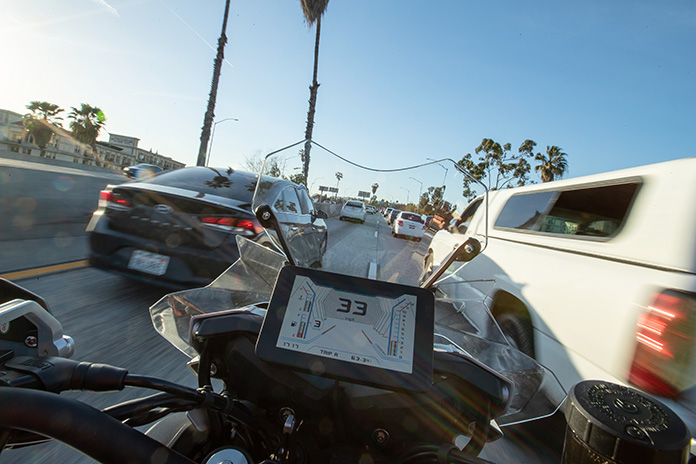
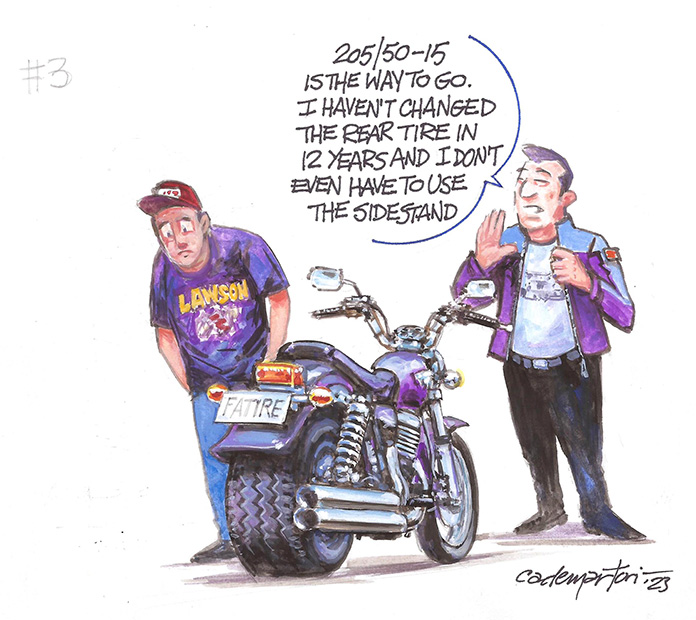
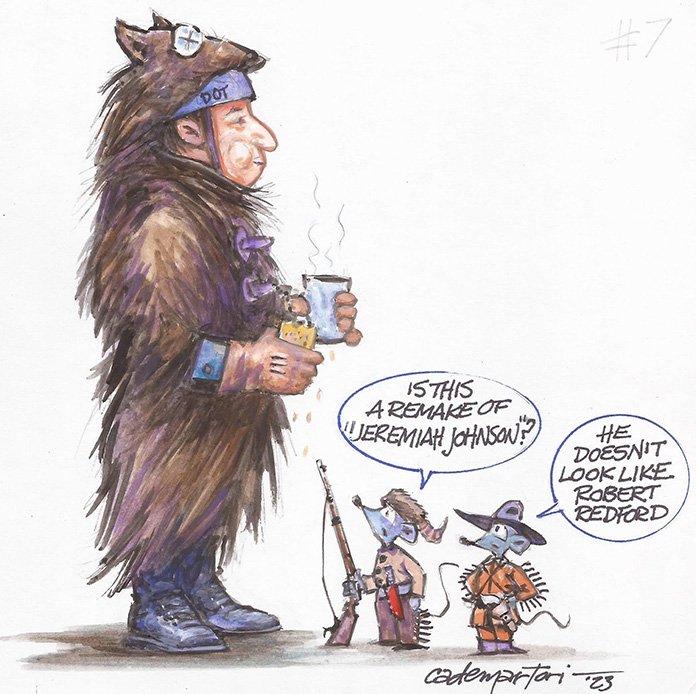
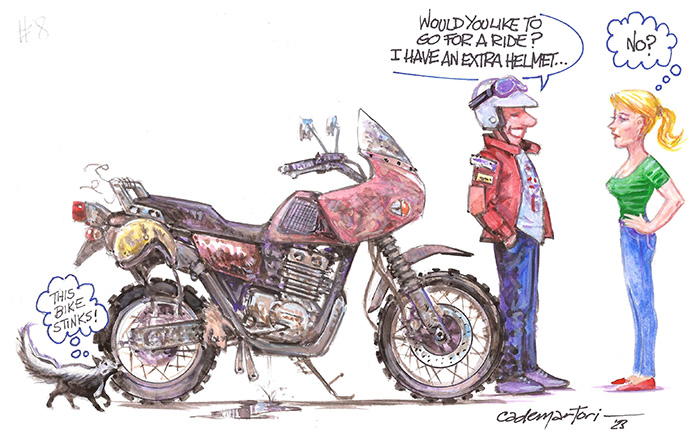
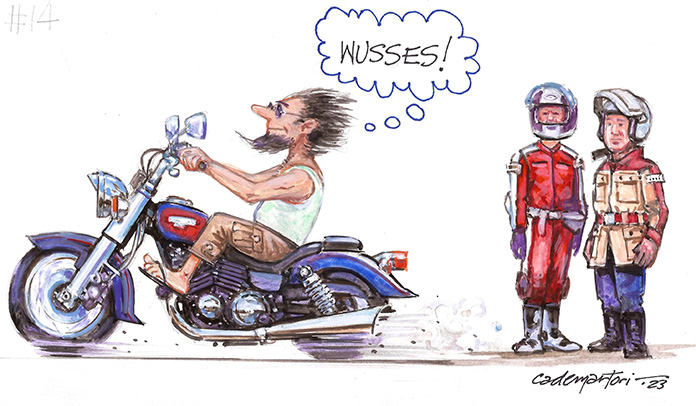
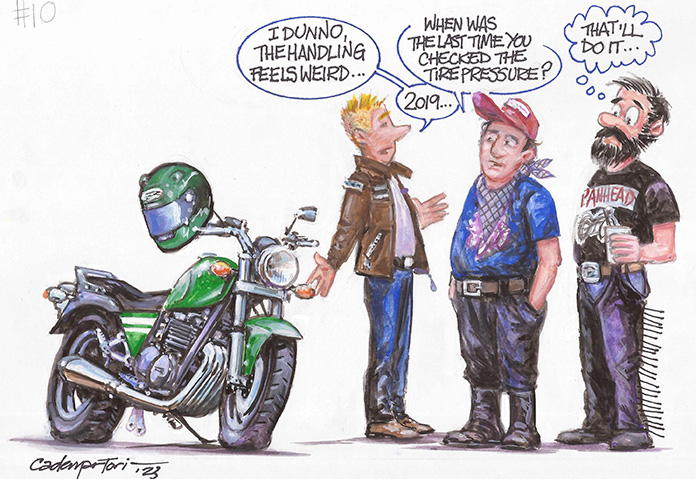







Valid myth-busting, but I am going to question you on one. #8 “Leather motorcycle apparel offers the best protection.” While I agree with your statements (mostly) with Kevlar and Cordua, I would pose this question. I leather is not superior, then why is it still the de facto material for all of road racing? Given that so much technology for motorcycles comes from MotoGP and on down, would they not be using primarily Codura with Kevlar, for its lightness and such while racing? Honest question and I look forward to your response.
Tim, good observation on road racing. I’ll need to check that. Although I’ve been to a lot of motorcycle races, including MotoGP, I didn’t carefully observe the materials of the participants. Thanks for reading so carefully.
Tim, I did some more looking around WRT your question on Leather vs. Kevlar and Cordura for MotoGP racers. You are right, those road racing suits contain leather. Based on a lot of research and studies I found, leather is ideal for slides. Kevlar and Cordura are stronger and more durable. I also found MotoGP suits contain Kevlar panels as well as stretch sections with elastic fabrics like Spandex. You’ll also find carbon fiber and D30 in the suits to protect shoulders, elbows, knees, and shins – strong but without impacting mobility. I hope this answers your question.
Kevlar and cordura in several studies show better protection from impact but lesser for abrasion. on the road the bigger issue is impact not abrasion. unless you are playing ricky racer which is a death wish anyway. Leather drawbacks .MAINTAINANCE> lether deteriorates rapidly unless manitained. Ihave experiance on damp leather (bates) tuning into a host for various aliein looking life forms back in my road racing days (I realluy men days..i succked)
#17. Concur re Jon & Ponch. Staggered column has its place but no, it is not the safest in most situations. Single column with 2+ sec gaps and full use of the lane should be the default. I hate seeing groups maintain staggered formation as roads get narrower and twisty. Break the habit.
Some myths are all garbage, but some have some truth to them. Agree with all but the following:
1. Loud Pipes – forest rats, ie deer, are one of the biggest dangers to bikes “in the wild”, off or on road. I’ve tried various “deer whistles”, even powered. None work as well as a loud exhaust. No, they don’t work for other drivers, but I’ve hit 4 deer and 0 other vehicles over my 800k mi of riding.
3. Darkside – There is certainly truth to the effect on bike dynamics as well as bead seating. Some rim/car tire bead combinations work, some don’t. I was a complete nonbeliever until I followed a bike with one for a day on twisty AR roads. I was thoroughly impressed with the corner speeds and lean angles he achieved (Honda VF1200). It put the debate to rest for me, though it’s not for me, and anyone considering it should do their research with those experienced in car tire use. For limited lean bikes, ie tourers and cruisers, it makes some sense.
6. Lane splitting – 40% reduction in traffic congestion? Talk about a myth, that’s complete BS. Old saying “figures don’t lie, but liars figure”. There aren’t enough bikes on the road, except maybe during a special event, for this to be accurate. While I would like to be able to do it, this type of hyperbole is just BS. I suspect that all the videos of Darwin Award candidates lane splitting at hi speeds helps keep states from allowing it.
Thanks for the comment, Doug. WRT to #1, I’ve done a lot of research in the past on the loud pipe myth and never found anything other than anecdotal that loud pipes have any impact, even on deer and animals. I’ve only ridden one bike with loud pipes in my 40+ years of riding, hundreds of thousands of miles and never hit a deer or been hit by one – which doesn’t mean anything either, its just another anecdotal data point. As to #2, I’ll still go with the engineers that designed the bike and what they recommend for tires. As to #3, I’m at a conference without my computer until next week, but when I get home I’ll check my source for the traffic reduction study. Thanks for reading and taking the time to respond.
loud pipies…Okay IF you want a loud pipe to warn other drivers about you. then you have to ppint the open end forward. the noise pattern of an exhaust pipe is a lot like a trumpet the noise exit in the direction of of the bore with faairly small side lobes (noise going forward). so in effect you suprise a car driver as you go past.
here is a controlled study showing that the MC is not heard until about 40feet away at BEST. giving no time for a car driver to react well.
https://motoadn.ro/test-motorcycle-loud-pipes/
I think a sound engineer could tell you that sound escaping from pipes in the back of the bike don’t make it to the front of the bike, if the theory is that cars in front of you will notice you because of loud pipes. I remember passing through a desert state a few years back in a car with my windows down and being used by an F-16 as a ground target practice. The jet came at me with full afterburner from a few miles away and I never heard it till it passed over me at maybe 50 feet and “scrambled my marbles”. Imagine the sound coming out of those engines at full afterburner and I couldn’t hear it till it passed over me. Same thing applies to bikes. Loud pipes are for attracting attention from everyone but the car that will hit you in an intersection you are about to enter. I have been riding since 1974 so I have a bit of experience in this matter.
Same thing happened to me, riding with a friend a few miles southeast of Rapid City, home of Ellsworth AFB. Didn’t hear a thing until WHAM! a fighter jet flew over very low and fast. I assumed he was trying to scare the two bikers into crashing, but we were both experienced riders and failed to take the bait. Same thing with loud pipes. Mine are not super loud, but there’s not much baffling in them. At highway speeds, the wind noise is louder. If I barely notice the pipes at only a couple of feet ahead of where the noise comes out, how can it be loud enough ahead of me to be any safety factor? The only time I was ever in a wreck was someone running a stop sign ahead of me. Obviously the noise of my bike was no deterrent.
OK Douglas, I’m back home, found my notes on the lane-splitting issue. The study I referred to (which was covered in this magazine) was at the University of California Berkeley by Dr. Thomas Rice of the Safe Transportation Research and Education Center. Key findings were: A. Lane-splitting is safe if done in traffic moving at 50 mph or less and MC’s don’t exceed the speed of other vehicles by more than 15 mph.
B. Those lane-splitting motorcyclists were “markedly less likely to suffer a head injury, torso injury or fatal injury than those not lane-splitting.” C. Lane-splitters were far less likely to be rear-ended than non-lane-splitting motorcyclists, as well as other findings. The full report is easy to find and downloadable. If you can’t find it, let me know, and I will email you a copy.
I believe my reference to a 40% reduction in traffic congestion was not in the report, but was a calculation made by an anlyst reading the report. To arrive at the 40% reduction number, they factored in the higher number of accidents among “non-lane-splitting riders” and the traffic delays caused when cleaning up those accidents – and arrived at an estimated impact on traffic congestion.
I disagreed with a few of these myself, good points. But if someone can outride you on a car tire, they just a better rider than you are.
Now I am laughing but as I reflect back on 60 years of riding, I knew/know guys who believe these things. PS back in the 60’s I found out that you have to be very careful of the front brake in the rain
Wayne, thanks for reading and the comments. During the riding training I did with both the AZ Highway Patrol and the Phoenix Police Department, they spent the good portion of a day on a flooded tarmac going through mostly brake exercises. You are right in the need to be careful, the my conclusion and experience reinforces that more accidents happen in too aggressive rear brake application than front brake use.
What would you say would be a good bike for a beginner
Small-displacement motorcycles, such as the CFMOTO 300NK or 300SS, Honda CB300R or Rebel 300, Kawasaki Eliminator or Z400, KTM 390 Duke, Yamaha MT-03 or V Star 250 are good bikes for beginners because they are lightweight and affordable.
This is a silly list. Myth #27, Motorcycles are safer than an SUV. What was the inspiration for this nonsense? A car tire mounted on a bike? What?
Snowdog, thanks for your comment. The inspiration for this came from hearing the same myths reported over and over – things I knew to be false and thought everyone else did, too. Not so. Just 10 days ago while riding old Route 66 through sections of northern AZ, we came across a fellow riding a 1990’s era Goldwing with an automobile tire on the back. When I suggested to him it may not be the best idea, he countered with how he gets “far more miles” on a car tire and they’re cheaper. Some people believe some crazy stuff.
I’m on my 3rd c/t on my 3rd Wing. Some C/Ts have more curvature than others, so you need to be selective for the best handling. Low speed (parking lots) can be tricky. “Ride it like you stole it” can be a good friend at the right time and right place. I will say this, never go “darkside” on the front. Being forced onto gravel roads for whatever reasons can become a handful in handling. .
A 2015 Consumer Reports survey? Geez, that’s only 9 years ago (almost). Why reference a report from then? Much has changed, for the better.
OK, Ed – so what is your newer source we can use as a reference..?
Loud Pipes Save Lives? Fun to debate. I don’t think so, but that’s just me. I do believe a statement I read a bunch of years ago that went something like this, “In a city (such as Phoenix, where I live) loud pipes irritate 5000 people per mile. And they vote.” I did some mental figgering and figgered, “Hmmm. three houses in on both sides of the road, 2 to 6 folks per, some apartment’s with 2 to 6 people per, some businesses . . . Yeah, could be.” So, on a 5 mile cruise through town you could irritate 25,000 voters, who just might think of you the next time some stupid anti-biking law is on the ballot.
Also, just for a second comment: I was once parked on a long lonely desert road for a photo shoot out by Frog Rock just north of Wickenburg, and I heard a GOLDWING coming up the mountain from over a mile away because he had his stereo going full blast! So it ain’t only loud pipes that are annoying. Gee, I feel as old as I am.
I’ve been riding daily since 1970, legally since 1974. Spot on. Maybe re wet weather gear. I wear all my waterproof protective gear then a1 piece plastic over suit and plastic over boots. That will keep hands and body dry all day. You won’t Leo hands dry. In the wet pot you good warm gloves in the top box and wear light gloves with handle bar heater on. When you ride out of the rain pot your nice dry warm gloves back on.
Riders that believe a car tire is a good option have “zero” engineering sense and even less common sense. I can’t even begin to explain how idiotic it is to run a car tire on a bike.
Good article I’ve heard and seen all of those bad ideas in my50 plus years of riding. One reason for “leathers ” still being still made of leather is it works well in regards to abrasion protection and does not melt like some synthetic material. Probably more important is some synthetic materials have such low drag factors that they don’t slow the rider down in a slide and even allow the rider to accelerate on impact. The first generation of synthetic race suits on the market failed due to their reputation for extending the length of the slide after impact. Of course this old information from my club racing days back in the 1970’s,when we had ancient technology.
Re: Myth #1, loud pipes are annoying when you are behind the noise at almost any distance short of a half mile. This comment is kind of about deer whistles. While riding through deer country on a 94 VFR I have noticed that deer seem to be more aware of the high pitch coming from gear driven cams. They perk up their ears and turn away quickly, and usually disappear to the forest every time. Just a theory, but I think it has merit due to the number of times I have observed it, although “simply paying attention” may be contributing to my experiment. Thank you for the article. As I used to tell my crew during safety meetings, it only takes a second to find yourself in trouble no matter what you’re doing. Pay Attention!
What I often see in my state (Arizona) is riders with loud pipes often don’t wear helmets, don’t wear armor, don’t wear reflective jackets or hi-viz gear and even go bar hopping. Yet they need motorcycles without mufflers to save their life?
Rider Magazine’s myth-busting article is a must-read for all motorcycle enthusiasts. The debunking of common myths provides valuable insights for riders, especially those new to the scene. I appreciated the well-researched information, helping me separate fact from fiction in the world of motorcycles.